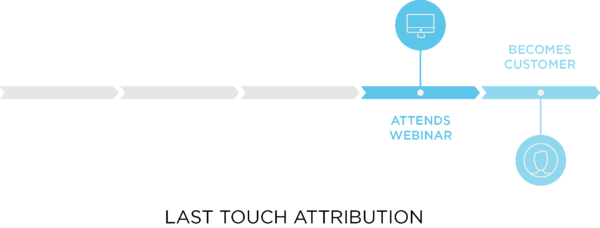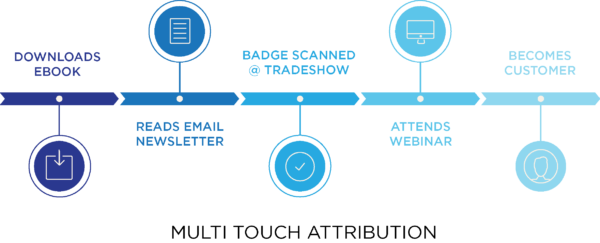ROI
Single-Touch Attribution: Mapping Marketing ROI Back to Content
Mapping ROI back to content isn’t easy, but it’s essential to determine the effectiveness of the content you create. With the complex marketing strategies most of us design today, models like “multi-touch” and “omni-touch” are crucial to genuinely mapping ROI to every piece of content in the buyer’s journey. These complex attribution models allow us to drill deep and get a more accurate picture of how our content influences buyers and where we may need to tighten our efforts.
But is complex always the right path? Single-touch attribution, where 100 percent of the conversion credit is given to one touch point in a buyer’s journey, can still have a place in modern marketing analytics.
Why Use Single-Touch Attribution?
Marketing teams that use single-touch attribution usually choose the first or the last touch point to qualify the lead as derived from marketing. So why use single-touch attribution in a 21st-century marketing context?
1. It’s easy to implement.
Marketers choose one interaction with a customer (often the first or the last) and credit the entire sale to that piece of content, regardless of how many touch points are created for the buyer’s journey.
This could be the social ad you ran on LinkedIn that first caught your customer’s attention which drove them to read a blog (first touch), or the webinar you offered that convinced the customer to purchase your service or product (last touch).
2. It’s easy to understand.
When tying ROI to the content, choosing one touch point is the simplest way to show how your content marketing efforts worked. It’s also the easiest to explain to leadership how you arrived at your conclusion (that webinar worked!) without needing a wall with yarn, pins, and a pad of stickies.

For example, a potential customer sees an ad for your product and signs up for a webinar. After attending the webinar, they purchase the product from the follow-up email. In first-touch attribution, the ad gets the credit for the sale. In last-touch attribution, the follow-up email receives all the glory.
3. Great for smaller companies.
Companies with simple marketing or sales systems (or no sales team at all), a shorter sales cycle, a smaller budget, or teams that only use one or two channels may find a single-touch model is a great option for them. There’s no need to over-complicate a process before it’s ready to become complex.
Challenges of Single-Touch Attribution
While single-touch attribution has a place in marketing analytics, it doesn’t come without challenges. The biggest: single-touch doesn’t capture the entire picture of how a customer moves through the buyer’s journey. Did they purchase your product based on that one ad they saw on TikTok, or did additional touch points (product reviews, blog posts, newsletters, etc.) influence their purchase? To truly understand how a customer went from interest to purchase, you need the complexity a multi- or omni-touch model provides.
The danger of putting all your analytics eggs in the single-touch basket is that the data will be skewed. Single-touch doesn’t look at anything else (touch point or channel) in the buyer’s journey, nor does it show which was the most effective. The buyer’s first encounter with a blog post may have set them down the path to purchase, but was it really the piece that moved them from consideration to purchase? Probably not, but it’s still an important part in the buyer’s journey. We can’t always assume the last touch point was what clinched the deal.
Use Single-Touch Attribution to Test Effectiveness
If you have a complex funnel with a longer buying cycle, it’s likely you use a multi- or omni-touch attribution model. However, single-touch attribution can still be used to test different channels or touch points within your marketing funnel for effectiveness or to answer specific questions you may have about your funnel.
For example, you may use social media, newsletters, blogs, and videos as top-of-funnel content. By taking a microscopic view of each channel, you can discover which ones drive the customer deeper into your sales funnel and can inform where you allocate more resources to drive more customers to a purchase.
Single-touch attribution can also provide insight into bottom-funnel content and how it influences customer decision-making. Do you have a higher conversion rate after reading a case study, or are webinars more effective? Do you see more sales after customers consider a side-by-side comparison with your competitor? Single-touch is also great for sales teams, as it can help determine which campaigns are instrumental to qualifying a sales lead.
Single-touch attribution doesn’t have to go the way of the 8-track just yet. It’s a great way to keep things simple when needed. If you’re already functioning in a matrix model, single-touch attribution can help you evaluate and fine-tune parts of your content marketing efforts.
Stay informed on the latest content trends, industry insights, and news. Subscribe to The Content Strategist to receive weekly updates.
Image by mathisworksGet better at your job right now.
Read our monthly newsletter to master content marketing. It’s made for marketers, creators, and everyone in between.







